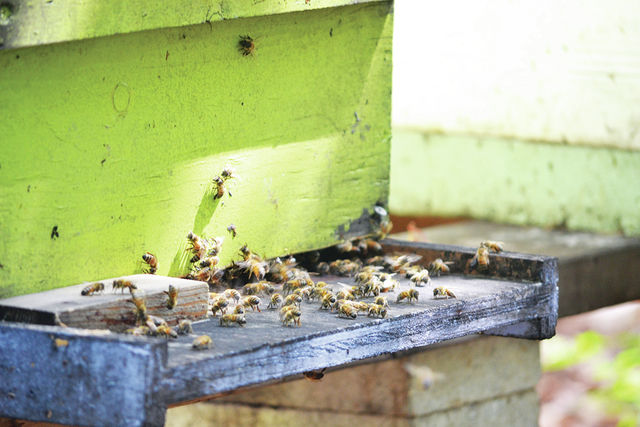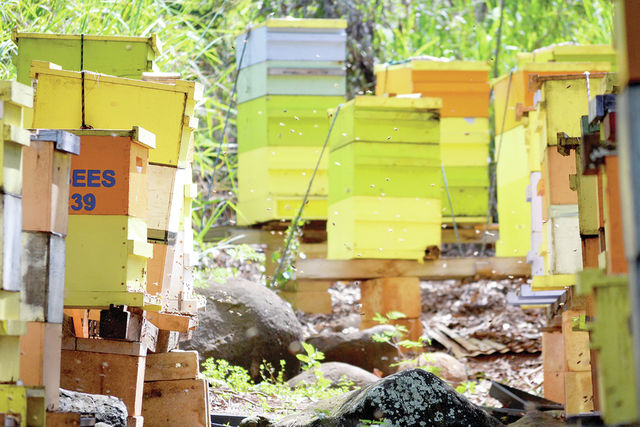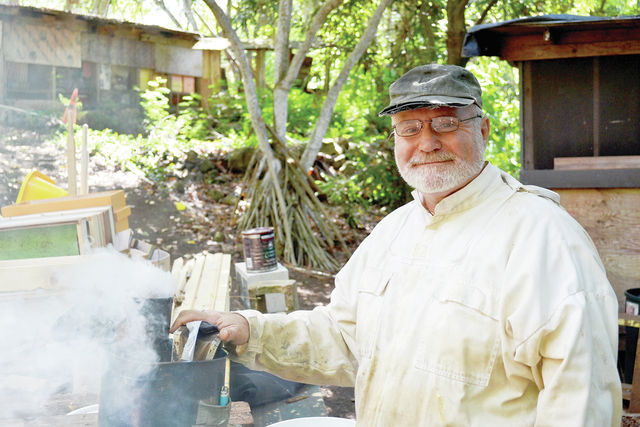Talk Story: Lee Wilke
Lee Wilke, Kauai Bee Association vice president, loves his bees.
The former construction work turned full-time beekeeper has an estimated four million bees on his property in Hanamaulu.
Twice a year, Wilke harvests 300 gallons of honey from his 110 hives in Puhi and Hanamaulu.
Originally from Wisconsin, the beekeeper has been on Kauai for eight years and enjoys the island lifestyle, its community and is always willing to mentor and educate anyone interested in bees.
And if you have a bee problem, chances are he’s one of the island’s beekeepers who will come to the rescue.
What got you into bees?
I never imagined being into bees before coming to Kauai, but this property here had four beehives in the walls and some in the buildings. I wanted to learn how to take them out, so I took some classes at KCC.
When did you do that?
About five years ago I started taking classes from Jimmy Trujillo to help mentor me. I took off: Learning the old way, new way of doing things, and I’m here today.
What was your first reaction to the class?
I wanted to save the bees, basically. My goal here on Kauai is to save bees not kill them, so I do bee removals. I tell the people I only save them. I don’t kill them — except for the extremes when it’s going to cost people thousands of dollars to take them out. I try to save as many bees as I can to keep that gender going. I try to help people that are allergic, older people that don’t have the money to pay for it.
What’s the importance of bees?
Of course, the pollination. They do about 60 percent of our pollination (of) plants. Without them, we’re going to be a mighty hungry planet really fast. We are blessed that we have so many wild swarms of bees that are out there. Bees got here in the 1700s, 1800s and the bees just spread through the island. Without them, we’d be hurting.
Tell me about the Kauai Bee Association.
It’s an association of beekeepers who are dedicated to keeping the bee going. They sell a little bit of honey, and we’re there to help teach people, bring beekeeping along here on the island. Jimmy and I sometimes get to sit in on a class. We’ll go to school and teach some classes on career day, bringing more people more aware of what’s going on with the bees and agriculture here on the island. I’m working on selling bees on the island, so people who want them can have them. There’s a bunch of us who have hives or sometimes we’ll catch a swarm and give it to them to start.
What are some of the things you do with bees?
Right now, I’m learning how to make bees which is a different concept than what I learned on the island. All the beekeepers here make honey. Now I’m expanding to make more hives, so that’s what I’ve been doing here for the past three months, four months.
Do we have enough bees on the island?
On this island, we have enough bees. There’s a lot of feral bees, but we need to watch and take care of them. We’re a closed island. You cannot buy bees or bring (them) on, and that keeps insects that we don’t want — the varroa mite, some other insects. The varroa mite could wipe out the whole population on Kauai. The varroa mite is about as big as a tick is to us. That’s about as big it would be to a bee. It’s hardly visible to the naked eye. It shortens the lifespan a great deal. It can wipe them out within a year. The varroa mite gets into a hive and they lay their eggs in the cells. The bee is born with the varroa mite on their body.
What are some of the misconceptions of bees?
People are worried about the Africanized bee. They come out in thousands and sting. The honey bee doesn’t really want to sting you. Most times people get stung if they come close to a hive; you get in their fly zone. If you approach them from the side, you’re not gonna get stung. If you do, you need to wash off right away because they put a pheromone that (signifies) danger, and they’ll continue attacking that one spot on you. I teach the kids: You gotta cover up, walk away and get away from the bees.
What are Africanized bees?
They’re hybrid bees. They’re going all across the southwest and are a great problem in the states. People are actually being killed by them because thousands (come) after somebody. We don’t have them on the island. We don’t want them here. The agriculture people are really working hard to keep anything coming from the port, especially from Oahu. They got one swarm in about three years ago, and they were able to contain it in a container. They’re on top of it.
What were some of your challenges when you got into beekeeping?
There’s just so much to learn: learning how to take care of them, learning their needs, how to build boxes, how to keep them. If you lose a hive, when you first start, you get remorse like you lost a child.
After you go through the teaching process, after you learn, what’s one of the first steps to create an apiary and maintain one?
It would be expanding your bees — if you’re going on getting swarms. You have to take them out of a wall or a tree or wherever they might be and put them in a box and make sure everything is watertight and they’re in good health.
How often do you remove hives from other people’s properties?
Right now we’re in the busy season the swarm season. I may get a call one to three times a week to take bees out at this time. We’re all busy, all the beekeepers. We’re all taking bees out of places. If someone’s allergic or someone’s children are there, I try to get to them first. If there’s bees that’s there that can be taken out at any time, then I just put that on the back burner when I can get to them.
In what areas of the island do you recover these hives?
Mostly (eastside). But I just went to Princeville Monday, and I was over there taking care of a swarm. I’ve gone all the way around the island.
What’s some of the most unusual places you’ve found a hive or swarm?
I’ve taken them out of the bottom of a tractor, boiler, washing machines, dryers, walls. I’ve carried one off the side of a cliff in Hanapepe. Years ago, someone dumped a gas can from a trunk off a cliff and it was hanging in a tree. The bees moved in there, so I went up there, wrapped it with screening and I carried it down.
Where do you take the bees after?
I take a lot of them up here right to my home here. I have some in Puhi and Lihue. I have two apiaries I work out of.
How big are your apiaries?
One in Puhi is about 20 hives and the one in Lihue is about 90.
How do you maintain all of them?
It’s a lot of work. I work seven days a week. I’ve turned full-time beekeeper about seven to eight months ago because you have to work them or lose them. I don’t want to lose the bees after working so hard to get them.
What do you love about bees?
They’re fun to watch. They fly back and forth. They don’t really want to hurt anybody. Occasionally I get stung, but it’s because I’m invading their area. I love what they do: They pollinate the flowers from our surroundings. The good Lord gave me some knowledge, I just take care of them for God.
What kind of products can you get from bees?
Of course, honey and wax. There’s thousand of things you can make wax out of. There’s lip balm, candles, soaps, different kinds of perfumes. What the bees make out of the pollen and the nectar make a bee bread out of it and the baby bees make royal jelly. I feed it to the brand new bees being born and put it in the cells with the eggs that turns into larva. So many things that we can use from the bees.




